Matthias Kränzler
Design Space Exploration at Frame-Level for Joint Decoding Energy and Quality Optimization in VVC
Oct 01, 2024


Abstract:In the pursuit of a reduced energy demand of VVC decoders, it was found that the coding tool configuration has a substantial influence on the bit rate efficiency and the decoding energy demand. The Advanced Design Space Exploration algorithm as proposed in the literature, can derive coding tool configurations that provide optimal trade-offs between rate and energy efficiency. Yet, some trade-off points in the design space cannot be reached with the state-of-the-art methodology, which defines coding tools for an entire bitstream. This work proposes a novel, granular adjustment of the coding tool usage in VVC. Consequently, the optimization algorithm is adjusted to explore coding tool configurations that operate on frame-level. Moreover, new optimization criteria are introduced to focus the search on specific bit rates. As a result, coding tool configurations are obtained which yield so far inaccessible trade-offs between bit rate efficiency and decoding energy demand for VVC-coded sequences. The proposed methodology extends the design space and enhances the continuity of the Pareto front.
* submitted, accepted and published at EuSipCo 2024, Special Session on Frugality for Video Streaming
Predicting the Energy Demand of a Hardware Video Decoder with Unknown Design Using Software Profiling
Feb 15, 2024Abstract:Energy efficiency for video communications and video-on-demand streaming is essential for mobile devices with a limited battery capacity. Therefore, hardware (HW) decoder implementations are commonly used to significantly reduce the energetic load of video playback. The energy consumption of such a HW implementation largely depends on a previously finalized standardization of a video codec that specifies which coding tools and methods are included in the new video codec. However, during the standardization, the true complexity of a HW implementation is unknown, and the adoption of coding tools relies solely on the expertise of experts in the industry. By using software (SW) decoder profiling, we are able to estimate the SW decoding energy demand with an average error of 1.25%. We propose a method that accurately models the energy demand of existing HW decoders with an average error of 1.79% by exploiting information from software (SW) decoder profiling. Motivated by the low estimation error, we propose a HW decoding energy metric that can predict and estimate the complexity of an unknown HW implementation using information from existing HW decoder implementations and available SW implementations of the future video decoder. By using multiple video codecs for model training, we can predict the complexity of a HW decoder with an error of less than 8% and a minimum error of 4.54% without using the corresponding HW decoder for training.
A Comprehensive Review of Software and Hardware Energy Efficiency of Video Decoders
Feb 14, 2024



Abstract:Energy and compression efficiency are two essential parts of modern video decoder implementations that have to be considered. This work comprehensively studies the following six video coding formats regarding compression and decoding energy efficiency: AVC, VP9, HEVC, AV1, VVC, and AVM. We first evaluate the energy demand of reference and optimized software decoder implementations. Furthermore, we consider the influence of the usage of SIMD instructions on those decoder implementations. We find that AV1 is a sweet spot for optimized software decoder implementations with an additional energy demand of 16.55% and bitrate savings of -43.95% compared to VP9. We furthermore evaluate the hardware decoding energy demand of four video coding formats. Thereby, we show that AV1 has energy demand increases by 117.50% compared to VP9. For HEVC, we found a sweet spot in terms of energy demand with an increase of 6.06% with respect to VP9. Relative to their optimized software counterparts, hardware video decoders reduce the energy consumption to less than 9% compared to software decoders.
Extended Signaling Methods for Reduced Video Decoder Power Consumption Using Green Metadata
Oct 26, 2023Abstract:In this paper, we discuss one aspect of the latest MPEG standard edition on energy-efficient media consumption, also known as Green Metadata (ISO/IEC 232001-11), which is the interactive signaling for remote decoder-power reduction for peer-to-peer video conferencing. In this scenario, the receiver of a video, e.g., a battery-driven portable device, can send a dedicated request to the sender which asks for a video bitstream representation that is less complex to decode and process. Consequently, the receiver saves energy and extends operating times. We provide an overview on latest studies from the literature dealing with energy-saving aspects, which motivate the extension of the legacy Green Metadata standard. Furthermore, we explain the newly introduced syntax elements and verify their effectiveness by performing dedicated experiments. We show that the integration of these syntax elements can lead to dynamic energy savings of up to 90% for software video decoding and 80% for hardware video decoding, respectively.
Video Decoding Energy Reduction Using Temporal-Domain Filtering
Jun 12, 2023Abstract:In this paper, we study decoding energy reduction opportunities using temporal-domain filtering and subsampling methods. In particular, we study spatiotemporal filtering using a contrast sensitivity function and temporal downscaling, i.e., frame rate reduction. We apply these concepts as a pre-filtering to the video before compression and evaluate the bitrate, the decoding energy, and the visual quality with a dedicated metric targeting temporally down-scaled sequences. We find that decoding energy savings yield 35% when halving the frame rate and that spatiotemporal filtering can lead to up to 5% of additional savings, depending on the content.
The Bjøntegaard Bible -- Why your Way of Comparing Video Codecs May Be Wrong
Apr 25, 2023Abstract:In this paper, we provide an in-depth assessment on the Bj{\o}ntegaard Delta. We construct a large data set of video compression performance comparisons using a diverse set of metrics including PSNR, VMAF, bitrate, and processing energies. These metrics are evaluated for visual data types such as classic perspective video, 360{\deg} video, point clouds, and screen content. As compression technology, we consider multiple hybrid video codecs as well as state-of-the-art neural network based compression methods. Using additional performance points inbetween standard points defined by parameters such as the quantization parameter, we assess the interpolation error of the Bj{\o}ntegaard-Delta (BD) calculus and its impact on the final BD value. Performing an in-depth analysis, we find that the BD calculus is most accurate in the standard application of rate-distortion comparisons with mean errors below 0.5 percentage points. For other applications, the errors are higher (up to 10 percentage points), but can be reduced by a higher number of performance points. We finally come up with recommendations on how to use the BD calculus such that the validity of the resulting BD-values is maximized. Main recommendations include the use of Akima interpolation, the interpretation of relative difference curves, and the use of the logarithmic domain for saturating metrics such as SSIM and VMAF.
Modeling of Energy Consumption and Streaming Video QoE using a Crowdsourcing Dataset
Oct 11, 2022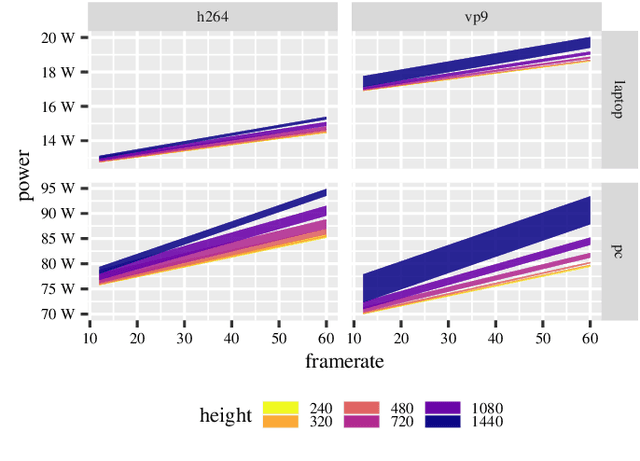
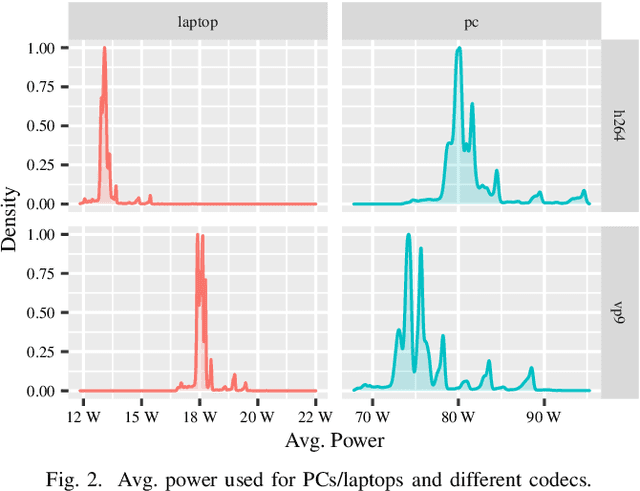
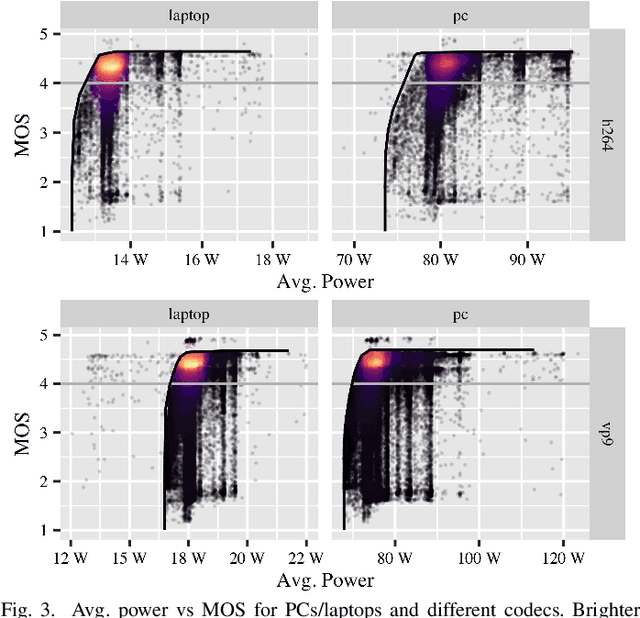

Abstract:In the past decade, we have witnessed an enormous growth in the demand for online video services. Recent studies estimate that nowadays, more than 1% of the global greenhouse gas emissions can be attributed to the production and use of devices performing online video tasks. As such, research on the true power consumption of devices and their energy efficiency during video streaming is highly important for a sustainable use of this technology. At the same time, over-the-top providers strive to offer high-quality streaming experiences to satisfy user expectations. Here, energy consumption and QoE partly depend on the same system parameters. Hence, a joint view is needed for their evaluation. In this paper, we perform a first analysis of both end-user power efficiency and Quality of Experience of a video streaming service. We take a crowdsourced dataset comprising 447,000 streaming events from YouTube and estimate both the power consumption and perceived quality. The power consumption is modeled based on previous work which we extended towards predicting the power usage of different devices and codecs. The user-perceived QoE is estimated using a standardized model. Our results indicate that an intelligent choice of streaming parameters can optimize both the QoE and the power efficiency of the end user device. Further, the paper discusses limitations of the approach and identifies directions for future research.
* 6 pages, 3 figures
Sweet Streams are Made of This: The System Engineer's View on Energy Efficiency in Video Communications
Sep 30, 2022



Abstract:In recent years, the global use of online video services has increased rapidly. Today, a manifold of applications, such as video streaming, video conferencing, live broadcasting, and social networks, make use of this technology. A recent study found that the development and the success of these services had as a consequence that, nowadays, more than 1% of the global greenhouse-gas emissions are related to online video, with growth rates close to 10% per year. This article reviews the latest findings concerning energy consumption of online video from the system engineer's perspective, where the system engineer is the designer and operator of a typical online video service. We discuss all relevant energy sinks, highlight dependencies with quality-of-service variables as well as video properties, review energy consumption models for different devices from the literature, and aggregate these existing models into a global model for the overall energy consumption of a generic online video service. Analyzing this model and its implications, we find that end-user devices and video encoding have the largest potential for energy savings. Finally, we provide an overview of recent advances in energy efficiency improvement for video streaming and propose future research directions for energy-efficient video streaming services.
A Comparative Analysis of the Time and Energy Demand of Versatile Video Coding and High Efficiency Video Coding Reference Decoders
Sep 21, 2022



Abstract:This paper investigates the decoding energy and decoding time demand of VTM-7.0 in relation to HM-16.20. We present the first detailed comparison of two video codecs in terms of software decoder energy consumption. The evaluation shows that the energy demand of the VTM decoder is increased significantly compared to HM and that the increase depends on the coding configuration. For the coding configuration randomaccess, we find that the decoding energy is increased by over 80% at a decoding time increase of over 70%. Furthermore, results indicate that the energy demand increases by up to 207% when Single Instruction Multiple Data (SIMD) instructions are disabled, which corresponds to the HM implementation style. By measurements, it is revealed that the coding tools MIP, AMVR, TPM, LFNST, and MTS increase the energy efficiency of the decoder. Furthermore, we propose a new coding configuration based on our analysis, which reduces the energy demand of the VTM decoder by over 17% on average.
Extending Video Decoding Energy Models for 360° and HDR Video Formats in HEVC
Sep 21, 2022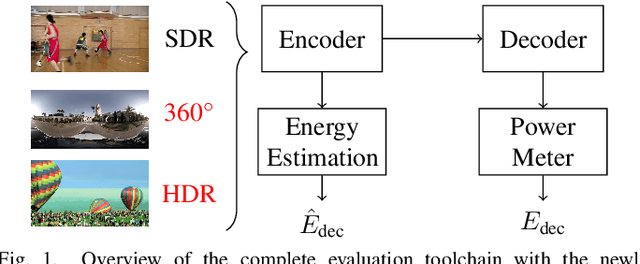
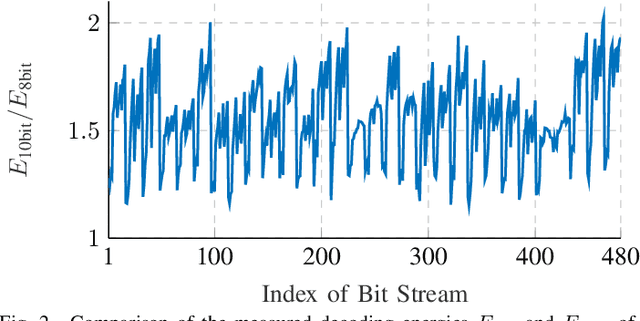
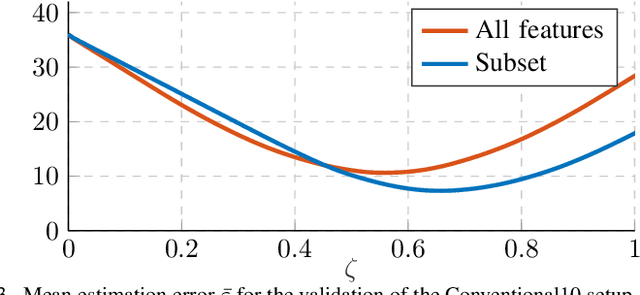
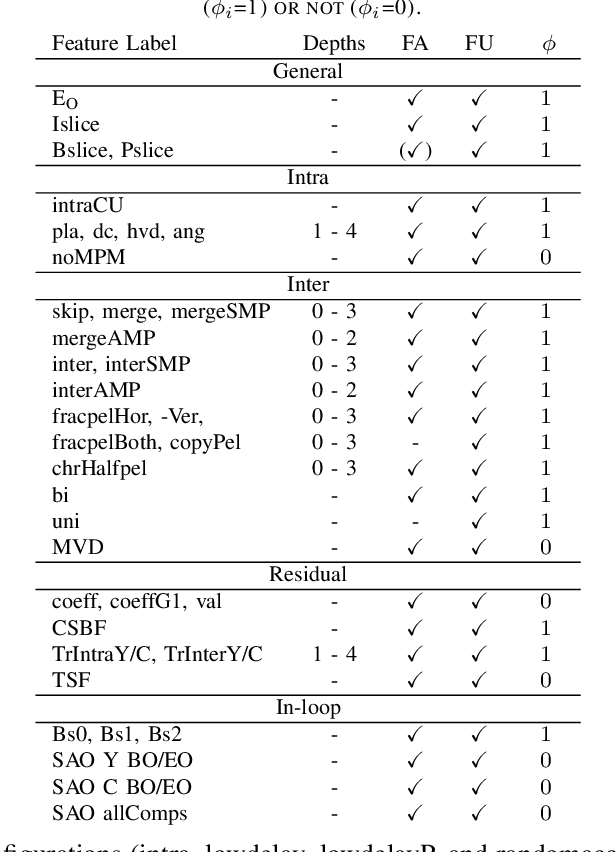
Abstract:Research has shown that decoder energy models are helpful tools for improving the energy efficiency in video playback applications. For example, an accurate feature-based bit stream model can reduce the energy consumption of the decoding process. However, until now only sequences of the SDR video format were investigated. Therefore, this paper shows that the decoding energy of HEVC-coded bit streams can be estimated precisely for different video formats and coding bit depths. Therefore, we compare a state-of-the-art model from the literature with a proposed model. We show that bit streams of the 360{\deg}, HDR, and fisheye video format can be estimated with a mean estimation error lower than 3.88% if the setups have the same coding bit depth. Furthermore, it is shown that on average, the energy demand for the decoding of bit streams with a bit depth of 10-bit is 55% higher than with 8-bit.
 Add to Chrome
Add to Chrome Add to Firefox
Add to Firefox Add to Edge
Add to Edge